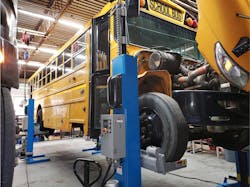Depot-Based Electric Vehicles Like ‘Mobile Microgrids to Support the Grid’
Electric buses, delivery trucks and other fleet vehicles are like mobile microgrids that can help balance the grid, and their depots offer huge potential to reduce peak usage through demand response programs that also yield income.
That’s the goal of CPower Energy Management, a distributed energy resource (DER) aggregator that recently partnered with Amply Power to provide resources for demand response programs.
Under the partnership, Amply manages electric fleet vehicle chargers to reduce their peak demand and provide value on-site. CPower provides services to the grid. CPower offers the fleets’ demand reduction as distributed energy resources to transmission and distribution grids, said Mathew Sachs, senior vice president of strategy and business development for CPower.
In the first project, which will launch this summer, the partners will work with Logan Bus, the largest school bus provider for the New York City Department of Education, with Amply managing the company’s electric bus chargers and CPower offering demand response from the chargers to the grid during peak hours.
“CPower is between the charging station and the grid so Amply can monetize the benefits they bring to the grid,” said Sachs.
Managing the draw of electric vehicles
As the move to transportation electrification continues, electric bus depots will create challenges for the grid through their power draws. It’s estimated that commercial fleets will increase to 8 million electric vehicles by 2030, boosting power consumption by up to 230 terawatt hours per year, which is about 6% of US power generation, said Sachs.
Managing chargers can reduce their draw at any one time significantly, said Vic Shao, CEO of Amply Power. For example, one of Amply’s clients, Anaheim Transit, has 46 fast chargers in one location, with a load of 4.8 MW. By ensuring buses aren’t all charged at the same time, Amply will limit the electrical draw at any one time to 2 MW.
“We don’t initiate charging for all 46 chargers at the same time. We do it sequentially and round robin and keep maximum demand below 2 MW,” said Shao.
To avoid grid outages for fleet operators, Amply has plans to provide microgrids at some depot sites, he added. None have been installed yet.
This is the first time CPower has worked with fleets, and the sector holds promise, said Sachs.
“These fleets represent challenges because they draw electricity. But they’re also a tool to address these challenges,” he said.
Fleets are especially attractive because it’s possible to predict when the electric vehicles will be on the road and when they’ll be sitting idle. School buses, for example, take kids to school in the morning, sit idle, then pick them up in the afternoon. They’re generally only driven about 60 miles per day.
School buses as mobile microgrids
“We know when buses will drop off kids and when they sit. Most of the time they are sitting. These are like mobile microgrids to help balance the grid,” said Sachs.
A school bus might return to a depot around 11 a.m. to charge when people are turning on air conditioners. At that point, the grid needs more energy. Utilities and grid operators could acquire the energy from peaker or other polluting plants — or they could acquire it from clean DERs such as bus chargers, he explained.
“The bus will stop charging or charge more slowly, using less energy. Multiply that by lots of buses,” said Sachs.
New York City is an especially good market because DER operators are paid well for capacity. Sachs wouldn’t say how much his customers make by participating in the program, but added, “It’s significant enough for them to work with us.”
Such programs will evolve and grow as regulations change, Sachs noted. Vehicle-to-grid services from electric fleets offer promise.
Join us at Microgrid 2021: The World Awakens to Microgrids, a virtual conference beginning May 11 to educate those who are exploring microgrids, Microgrid 2021 offers lively discussion panels, webinars, interviews with experts, virtual tours, workshops, live audience Q&A sessions and networking. Registration is free if done in advance.
CPower has been aggregating resources for a number of years and began by curtailing commercial and industrial loads during peak hours, said Sachs. As technology evolved, the company began offering microgrids, batteries, solar and backup generators as DERs in many markets. The company now has about 4 GW of load aggregated over 11,000 sites that include data centers, hospitals, municipalities and other commercial and industrial customers. CPower offers its DERs to 60 programs nationwide, including regional transmission operators, independent system operators and utilities.
While CPower works with grid operators and utilities, Amply focuses on commercial vehicle fleets, trying to address challenges that make it difficult for them to go all electric.
“We charge when it’s most cost-effective. We boil down the business value to an easy option,” said Shao.
Electric fleets must deal with the fact that the price of electricity for these commercial customers can fluctuate by 400% on a daily basis. This can make budgeting difficult.
What’s more, fleet operators must deal with each utility’s unique cost structure. Fleet owners with multiple depots — sometimes across the street from one another — may find themselves grappling with different rate structures that have a big impact on costs. One utility might say that under time of use rates, peak hours are noon until 6 p.m. Another might say peak hours are 4 p.m. to 9 p.m., Shao said.
In addition, fleet operators must often build the charging stations. Amply addresses such issues by providing the charging stations and charging customers by the kWh, a strategy that Shao hopes will encourage more companies to transition to electric vehicles.
Road to clean energy
For CPower’s Sachs, working with fleet operators — especially school bus operators — yields another important benefit. They’re often transitioning from diesel to electricity, which is much cleaner.
“I don’t love the fact that 95% of school buses are diesel. If we are going to green this country, starting with kids is a good place,” said Sachs.
Track news about electric vehicles as mobile microgrids. Subscribe to the free Microgrid Knowledge newsletter.








